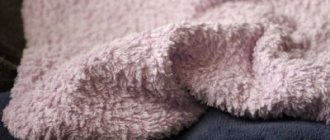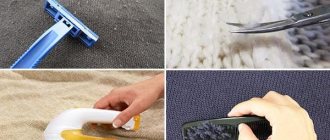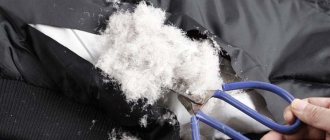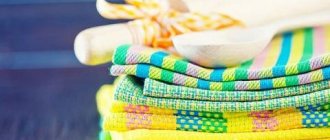Not all housewives can boast of the softness of terry towels. Terry fabrics quickly lose their “fluffiness” under improper washing and even storage conditions, so hard towels are a problem that requires a special approach.
Is it possible to revive old hard terry towels, and how to care for new ones - we study and remember!
In addition, towels become stiff due to...
- Low-quality cheap washing powder , which is difficult to rinse out of fabric fibers. Phosphate-based powders spoil terry towels especially quickly.
- Increased water hardness . The more calcium and magnesium in the water, the faster the terry towel becomes unusable.
- Incorrect washing mode . Usually, softness disappears when the temperature is set incorrectly (too high) and the spin power is high.
- Too dry air . At low humidity (approx. - below 20 percent), towels dry out and lose their fluffiness.
- Regular ironing. Alas, ironing terry towels in the classic way is not recommended.
- Low quality fabric. The lower the quality, the faster the towel loses its attractiveness.
“Taboo” for terry towels
An invigorating shower or warm bath with aroma oils. Everyone dreams of this, especially after a hard day’s work. Gentle touches, soft movements, a fluffy wave of terry loops after a shower, bath or sauna gives its owner a towel. But this is provided that it is really tender and fluffy. But very often, a new terry cloth ceases to please and relax, but, on the contrary, stresses and irritates.
Why are terry towels hard after washing? A question that worries everyone: both those who take care of their fluffy hair, and those whose bodies are accustomed to the gentle touches of the hair. Housewives, administrators of hotels, hotels, saunas and sports complexes are daily looking for ways (both improvised and professional) to fill personal hygiene items with fluffiness and tenderness. The towels have become hard because the washing and rinsing process is disrupted, inappropriate products are used, and poor quality water is used for washing.
How to make towels soft and fluffy when washing by machine and hand - 8 ways
Among the most popular and effective ways to return fluffiness and softness to your favorite textiles are the following:
- Salt . Experts advise choosing “extra” salt, which dissolves faster than others. It also makes sense to use products that are created specifically for automatic machines - just pour it in with regular powder, or dissolve it first in water - and pour it directly into the tank.
- Soda. We use both regular baking soda and calcined soda. The method of use is also simple: pour the product directly into the drum to soften the water during the washing process.
- Vinegar . This product not only returns softness to towels, but also completely eliminates even stubborn old odors. We use 9% table vinegar, no more than ½ cup.
- Vinegar with soda. You can use these products at the same time: pour the vinegar into a special compartment for the air conditioner, and pour the baking soda directly into the drum. Next, add the usual detergent and turn on the desired program.
- Soak. After machine washing, soak terry towels for 12 hours in cold (!) water. Then we rinse it and hang it to dry in a room with high air humidity.
- Homemade mouthwash. Mix vinegar, soda, plain water, and after foaming - water again. To add aroma to the conditioner, add essential oil. Now we pour the product into a regular bottle and use it like a regular mouthwash.
- Ammonia and salt. Dissolve a teaspoon of ammonia and 1 tablespoon of salt in 1 liter of water. Soak a towel in this solution (cold) for a couple of hours, then rinse and dry in a room with high humidity.
- Balls/balls. For perfect washing and keeping the pile in its original state of fluffiness, you can use tennis balls when washing. Throw 2-3 classic yellow balls into the drum of the washing machine - and you don’t have to worry about the hardness of the towels.
How to wash terry cloth
To soften terry products, you need to use white table vinegar. Dark can cause darkening of light terry fabric. If the required ingredient is not available, it is allowed to use table salt. For 1 liter of warm water, take a tablespoon of the softening component.
An alternative to this method is a mixture of washing powder and sea salt. Otherwise, the procedure does not differ from the algorithm described above. Terry products remain to be rinsed (at least 3 times) and carefully hung in a suitable place.
The following rules for washing and drying towels will help maintain fluffiness:
- We use only soft gel products for washing terry towels , and be sure to add a softening agent - salt, soda or vinegar. Don't forget about water softeners! We buy detergent without sophosphate and without chlorine in the composition. When choosing a conditioner, pay attention to a product with silicone, which helps maintain the fluffiness of towels.
- We always turn on an extra rinse so that not a trace of detergent remains in the fabric. For manual rinsing, change the water 3-4 times.
- We do not dry towels in rooms with dry air - this fabric needs high humidity when drying! It is recommended to hang it to dry horizontally.
- Towel washing mode : set the temperature to no more than 40 degrees.
- Spin speed – no more than 400 rpm. When manually squeezing, don’t get carried away!
- We do not push towels into the drum - we leave 1/3 of the space of the drum free from things. And add tennis balls before washing to “fluff up the lint.”
Features of the softening procedure depending on the material
The following main types of fabric are used to make towels:
- Terry. Such items should be washed and rinsed in large quantities of water. It is better to wash with liquid detergents at a temperature not exceeding 60 degrees. Spin at 400–500 rpm. Ironing is not recommended. To add softness, it is possible to use all known methods.
- Cotton. Universal towels. Widely used for body and kitchen needs. The products can withstand high temperatures and spinning, but shrink and become very wrinkled. Softness is returned in all the ways described above.
- Bamboo. These towels remain soft even after 500 washes. Wash well at 300 without using bleaches or softeners. Spin at low speed is recommended.
- Velours. Wash at a temperature not exceeding 40 degrees. Retains softness when gently pressed and ironed with a warm iron. Some manufacturers do not recommend ironing products.
- Microfiber. It is of artificial origin. Products made from this fabric are soft and pleasant to the touch. They can be washed both by hand and in the machine. Do not use bleaches, softeners, or conditioners. No ironing required.
- Linen. Hard to the touch. Used as kitchen hand towels. White ones can be boiled, and colored ones can be washed at a temperature not exceeding 600. Iron with a well-heated iron.
Manufacturers may add a certain percentage of synthetic fibers to the main types of fabric, so recommendations for caring for products made from the same fabric differ.
Terry towels have become stiff, what should I do?
Practical tips will help restore terry products to their former tenderness. By adhering to them, you can quickly, effectively, and, most importantly, inexpensively “give away” what is sometimes so lacking. To keep the towel soft after washing , you need to follow the following recommendations:
- Products should be washed with a special ball designed to break up terry threads and fluff. Using it, you can completely abandon the chemicals purchased specifically for fluffing terry.
- Fabric softener must contain silicone. It is this substance that keeps the pile soft.
- Be sure to follow the recommendations from the manufacturer. The information on the tag is a signal to select the temperature and speed of the washing machine.
- Do not iron towels. Under the influence of heat, the terry threads become tangled and the product becomes stiff. An alternative would be desoldering. Steam, on the contrary, “raises” the villi, and the towel is not only soft and fluffy, but also looks very voluminous.
- After washing, it is recommended to shake the fabric so that each of the loops, pressed during the washing process, can return to its original state.
How to determine the water hardness in your tap water
At first glance, it may seem that the question is supposedly off-topic. But, if you consider that this property of water directly affects the quality of washing, then it no longer seems so inappropriate. If anyone didn’t know, the water that flows through the pipes is by no means the same for everyone, and its quality in different regions, and even districts or villages, differs significantly.
If you are wondering how suitable your tap water is for washing your terry products, and whether you should use softening agents, then you will simply need to find out the hardness of your tap water. Let’s try to do this at home, without resorting to official data, which, as a rule, is distorted and untrue.
Using soap
- Finely crumble the soap into the water. If it is almost all dissolved, then it is soft. If there are a lot of floating particles left, then, alas, its quality leaves much to be desired.
- Wet your hands under the tap and lather. If your hands wash quickly and easily, then everything is fine. If it’s difficult, then you have a very hard liquid flowing in your pipes.
With tea
Brew black tea, preferably loose leaf, and after a few minutes notice its color. If it is light and bright, then everything is fine, if it is dark and cloudy, then this indicates hard water.
Please note: when using liquid detergents, you should not blindly believe what is written on the packaging, especially if it concerns the amount that you are recommended to use once. Any manufacturer of household chemicals is interested in you using up as much of their product as possible, so that you run out of it faster and come back tomorrow to buy a new one. Always use slightly less than the recommended amount, by at least a quarter. Believe me, nothing bad will happen.
We hope that you learned a lot from this article and that it was useful to you. Wishing you soft terry products and home comfort!
How to dry and iron correctly
Let's remember the negative aspects that were qualified as the reasons for the negative impact on the softness of terry towels. Among them was ironing. This fact must be remembered well. The pressure and hot surface of the iron will knock off the terry threads. Undesirable stiffness will appear.
When spinning, do not twist the textile into a rope or tie it in knots. Wring things out using moderate pressure.
You should refrain from using a heated iron. Hot steam will help level the surface of the towels that are in a suspended state. This is called steaming and is seen as a better alternative to ironing. The steam helps the pile rise. The towel becomes soft and voluminous.
Use vertical steaming.
Why did the fabric become stiff after washing?
An element that is insignificant at first glance, but adds comfort - a terry towel - affects the emotional background of the person who uses it. After a relaxing session in a hot bath or shower, you need a soft towel. Only with his help will the procedure be complete and complete.
There are several reasons why terry becomes rough, regardless of whether hand or machine washing was used:
- City water contains a lot of lime salts, which become insoluble when heated and settle on things.
- Mahra has a negative attitude towards powders. Therefore, it is better to use liquid rather than dry textile products.
- Improper washing also implies an overly aggressive mode: high water temperature, insufficient rinsing, high-speed spin.
- Soft towels should never be boiled or ironed without steaming. The fibers stick together, and the material loses its softness and fluffiness.
- Bleaching should be avoided. As a last resort, carry out the procedure before or after washing.
In order for the product to always remain soft, you need to take care of it seriously and use the right tools and auxiliary substances.
Expert recommendations
The rigidity of terry towels is not a death sentence or a reason for their disposal. At least until methods have been tried that make it easy to restore the former softness of these things. Moreover, it is not necessary to purchase any additional and expensive preparations to restore the fluffiness of bath products.
Everything you need is available in any home. In addition, part of the process of returning the pile of your favorite towels to the resemblance to chicken down does not even involve the use of any mandatory products.
Additional tips:
- When choosing soda ash, they prefer regular baking soda. Because the first one can cause irritation on the skin.
- Well-treated towels, dried in the fresh air, have their own pleasant smell of impeccable cleanliness. If you want to give them an additional aroma, instead of using a perfumed mouthwash, use empty bottles of your favorite perfume, bars of dry toilet soap, and sachets with aromatic herbs.
Even with little experience in housekeeping, you should not be discouraged if it turns out that terry towels are no longer as pleasant to the touch as before. This incident is common and can happen to anyone. Fortunately, the fix is quite simple. The main thing, as they say, is desire. Well, a little understanding of the essence of the problem.
How to wash a towel so it's soft
Careful attitude is the key to preserving the fluffiness and tenderness of the product. If you practice proper care, your towels will never become stiff.
Liquid detergents
Preference should be given to substances of medium or high cost. They, as a rule, consist of natural ingredients and are harmless to tissue and the human body. In addition, environmentally friendly products do not contain chlorine and phosphates, the effect of which negatively affects the condition of the fabric. If, in the case of simple textiles, pellets appear, then the terry begins to become coarse.
Tip: when using washing powder, use it to a minimum. At the same time, choose a cycle with additional rinsing - up to 3-4 times. A large amount of water will wash away the remaining chemicals on the item, which will help the situation a little.
Water quality and vinegar
If the main liquid is of increased hardness, which is easy to notice by the amount of scale on pots, in a kettle or other heating devices, it needs to be softened. To do this, just add 150 ml of the substance per 10 liters of water. If machine washable, pour half a cup of vinegar into the conditioner or conditioner compartment. During the final rinse, it will react with the minerals and salts in the water, making it softer.
Tip: It is not recommended to mix vinegar with fabric softener - the reaction will begin earlier than necessary, and the use of the product will be useless.
Gentle mode
Terry towels should be washed at temperatures up to 40 °C. The time period should be as short as possible, and the rpm should not exceed 400.
It is better to abandon the water-saving mode, since the more thoroughly the item is rinsed, the softer it will be. The drum can be loaded no more than 2/3 of the total volume. It's good if it's only towels.
Conditioner with silicone
Regular conditioner should not be used; it is not suitable for terry. Children's mouthwashes or those containing silicone are ideal. With the latter, the main thing is not to overdo it, otherwise the towel will lose one of its main properties - it will become poor at absorbing moisture.
Important: When using any liquid detergent or conditioner, you should not trust everything that is written on the package. The manufacturer indicates in the instructions the maximum permissible dosage that will be safe. It is recommended to measure a little less, at least 1/4. Thus, you will be able to save money, but the effect will be similar.
Terry massage ball
Special plastic devices are loaded into the drum along with things. During washing, they break the fibers, fluff up the loops, making the towel fluffy and soft again.
Spin
If there are problems with drying, and things that are too wet after washing may stick out, it is allowed to do a machine spin at 500 revolutions of the centrifuge. In case of excellent ventilation conditions, for example, an opening balcony, etc., it is recommended to perform the procedure at 300-350 rpm.
Tip: in programs for woolen items there is practically no spin, which is ideal for towels.
Drying
An equally important point in caring for terry items is drying. It also has certain conditions, compliance with which affects the softness of the products.
Vertical or horizontal drying type is recommended. But in any case, before doing this, you need to shake the towel thoroughly so that all the fibers straighten out and fluff up under the influence of the air flow.
- Mahra loves the breeze. Things dried outside acquire not only special tenderness, but also a unique aroma.
- You can also dry it in a special electric device.
- Items made from terry cloth should be removed on time, otherwise they begin to become rough.
Important: it is not recommended to dry towels with an iron, but steaming them to smooth out wrinkles will be useful.
What does the tag say?
A label with instructions for cleaning the product will help you figure out how to properly care for your terry towel. But basically the recommendations boil down to the fact that you can wash, hang dry and do not use bleaches. Most often, the towel label contains the manufacturer's logo, which does not provide any assistance in caring for it.
Add salt
Regular food seasoning softens water. It is enough to add it in the amount of 3 tbsp. into the dispenser or dilute with water and pour directly into the tank.
Add soda
Has a positive effect on fibers, making them softer. You need to pour 4 tbsp into the washing powder compartment. baking soda. The action is similar to vinegar.
What mode should you use to wash?
Load products into the machine only one third of the way through the drum. It is recommended to spin at a speed no higher than 500 per minute.
When using intensive mode, terry fibers stretch and lose their attractive appearance. It is best to set the rinse mode to three times a day.
Selecting the water temperature
The water temperature should not be higher than 40-60 degrees. This is the best option to preserve the structure of the fabrics of the products.
When using the boiling method, the fabric quickly wears out and loses its former attractiveness. Before the procedure, you should read the instructions on the tag: they usually indicate the temperature regime.











